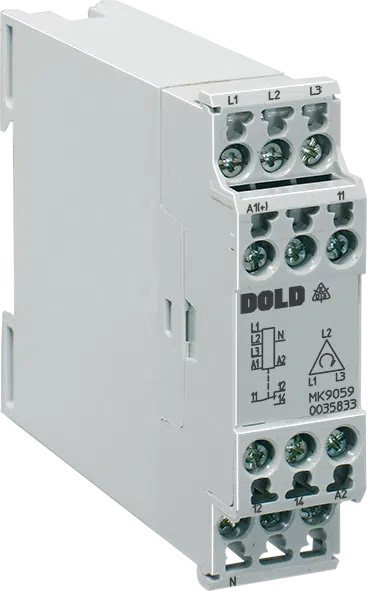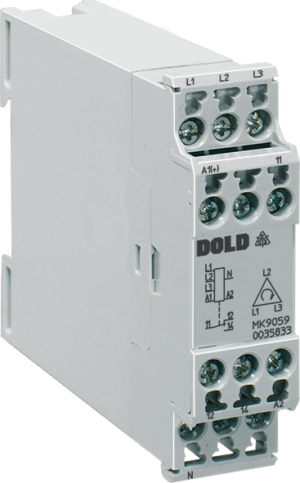What are Phase Sequence Relays?
Definition and Basic Concept
Phase sequence relays are protective electrical devices designed to monitor the correct order of phases in a three-phase power system. They ensure that the sequence of the three-phase supply (typically L1, L2, L3) is correct to prevent reverse rotation or malfunction of three-phase motors and other critical loads. A relay will only activate when the correct phase sequence is present, helping to maintain stability in 3-phase systems and across a variety of voltage systems.
Importance in Electrical Systems
Incorrect phase sequencing can lead to serious equipment failure, mechanical damage, or operational hazards—especially in rotating machinery. Phase sequence relays help eliminate this risk by continuously monitoring phase order and providing immediate response when an error is detected. The detection of an incorrect phase sequence or phase failure allows the relay to disable the output, protecting the system. These relays also play a role in identifying issues such as phase asymmetry and phase outage, both of which can disrupt normal operation.
Functionality of Phase Sequence Relays
How They Detect Phase Sequence
Phase sequence relays detect the direction of the rotating magnetic field in a three-phase system. Using internal logic or phase comparator circuitry, they determine if the input sequence is clockwise (correct phase sequence) or counter-clockwise (wrong phase sequence), and activate the output relay accordingly. Monitoring the balance between phase voltages ensures consistent detection of abnormal patterns and helps track critical electrical variables in real-time.
Role in Monitoring Phase Loss
Many modern phase sequence relays also detect phase failure. This occurs when one of the three phases is absent due to a wiring fault, fuse blowout, or upstream failure. The relay quickly disengages the connected load, protecting equipment from running under unsafe conditions. Some advanced models also monitor for phase asymmetry or large deviations in phase voltages, offering greater protection. Detection of phase failure is critical in maintaining uninterrupted service and equipment longevity.
Integration with Electrical Systems
These relays are typically mounted on DIN rails within control panels and integrated with contactors, motor starters, or programmable logic controllers (PLCs). They include relay outputs with a changeover contact for alarms or shutdown procedures, offering a simple interface with broader industrial automation systems. As relays for network monitoring, they serve as central components in power quality management and fault prevention architectures.
Variations for Different Voltage Supplies
Phase sequence relays are available for multiple voltage ranges including:
- 208–240V AC
- 380–480V AC
- Universal voltage ranges (e.g., 100–500V AC) This allows flexibility for international applications and different power infrastructures across varied voltage systems.
Stock Availability and Popular Accessories
Most standard models are readily available through industrial distributors and online platforms. Common accessories include:
- DIN rail mounting clips
- Wiring adapters
- Auxiliary relays for signal extension
- Protective enclosures for harsh environments
Applications of Phase Sequence Relays
Use in Industrial Systems
These relays are widely used in industrial automation for motors, pumps, compressors, HVAC units, and conveyor systems. They prevent equipment from running in reverse or underpowered conditions caused by a wrong or incorrect phase sequence.
Role in Preventing System Malfunctions
Phase errors such as phase failure, phase outage, or incorrect phase order can result in system shutdowns, overheating, or motor burnout. By detecting these conditions early, phase sequence relays act as a first line of defense against electrical malfunction.
Enhancing Electrical Safety and Efficiency
Phase sequence relays contribute to overall plant safety by shutting down non-compliant systems and reducing wear-and-tear caused by improper rotation. They also help reduce energy loss and improve system uptime in 3-phase systems and unbalanced voltage environments.
Technical Specifications
Electrical Specifications
- Operating voltage: 208–480V AC (depending on model)
- Standard measuring range: 100–500V AC
- Frequency: 45–65 Hz
- Input impedance: >200 kΩ
- Output contact: SPDT or DPDT changeover contact, 5A at 250V AC
- Auxiliary voltage: 24V AC/DC or built-in depending on model
- Response time: <200 ms
Construction Specifications
- Mounting: DIN rail (35mm)
- Width: typically 17.5mm–45mm
- Terminal type: screw terminals or push-in connectors
- Housing: Flame-retardant polycarbonate (UL 94 V-0)
Environmental Specifications
- Operating temperature: -20°C to +60°C
- Storage temperature: -30°C to +80°C
- Protection rating: IP20 (internal), IP40 (front panel)
- Certifications: CE, UL, cUL, RoHS
Related Technologies
Inductive Signal Transmission
Used for contactless signal transfer in rotating equipment, inductive transmission works well alongside phase monitoring for real-time motor diagnostics.
Encoders in Electrical Systems
Encoders measure rotational position and speed. Coupled with phase monitoring relays, they enable precise control of motor direction and acceleration.
Mains Monitoring Equipment
Devices such as under-voltage, overvoltage, and asymmetry monitors are often combined with phase sequence relays for complete power quality protection.
Benefits of Phase Sequence Relays
Ensuring System Reliability
By maintaining correct phase order, these relays ensure consistent performance of motor-driven equipment, reducing maintenance events and responding accurately to phase voltages and other electrical variables.
Preventing Operational Downtime
Quick detection of faults such as phase failure, phase asymmetry, and incorrect sequence leads to rapid shutdown or correction, minimizing production delays and equipment wear.
Maintaining Operational Efficiency
They help reduce the risk of energy loss, prevent misoperation, and support long-term cost savings by extending the life of electrical components and ensuring stable operation across all voltage systems.

